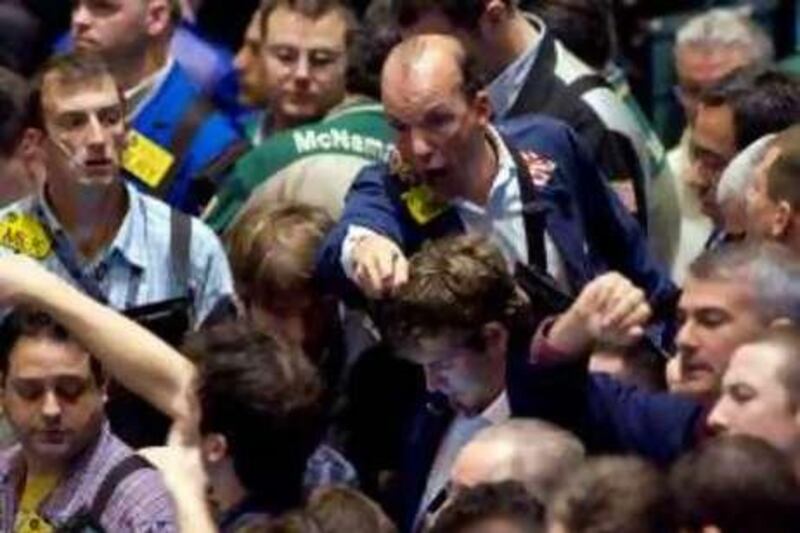Oil prices have sunk close to break-even for Saudi Arabia, the world's biggest oil producer, and are hovering at near half the level that Iran would need to balance its fiscal budget. The development could usher in fiscal austerity drives around the Gulf, with delays to major industrial, infrastructure and energy projects subduing economic growth in a region that seemed well shielded from financial and economic meltdowns in the rest of the world. But with crude's descent to below US$50 a barrel on Thursday - a level last seen in early 2005 - that is clearly no longer the case. "Everyone is suffering from the crisis and everyone needs treatment," said Jose Manuel Barroso, the president of the European Commission. Already, Saudi Arabia has put two big refinery projects on hold and is taking steps to slow its US$9 billion (Dh33bn) Manifa development, which was expected to pump 900,000 barrels per day (bpd) of crude from a giant offshore oilfield. Halliburton, the international oilfield services company, recently told investors that its contract with Saudi Aramco to drill 93 wells at Manifa would be pursued more slowly than originally planned, at the Saudi national oil company's request. The Italian contracting firm Saipem last week denied rumours that Aramco had cancelled its multibillion-dollar Manifa construction contract, but said it had been asked not to undertake further commitments to suppliers or subcontractors while awaiting the results of a cost analysis study. Earlier this month, Aramco sent letters to Manifa's three main engineering, procurement and construction contractors - Saipem, Japan's JGC and Spain's Tecnicas Reunidas - asking them to limit their activities to preliminary engineering work. Another Saudi project targeted for spending cuts, according to Aramco's incoming chief executive, Khalid al Falih, is the Karan offshore gas development, for which cost estimates have mushroomed in the past year. A decision to delay the big gas project would be a strong indication that the kingdom's government is facing a fiscal bind, as it would worsen a domestic gas supply crunch that is causing power cuts. The remedy, analysts suggest, would be to cancel or postpone petrochemical projects to allow industrial gas to be redirected to commercial and residential markets, a measure that would slow Saudi Arabia's drive to wring more value from its crude supplies by processing more oil at home. In a report on the Middle East last month, the International Monetary Fund (IMF) calculated that Saudi Arabia would need an average oil price of $49 a barrel to balance is budget for the 2008-2009 fiscal year ending on March 31. It estimated $47 a barrel as the average fiscal break-even price for GCC countries. Several analysts have reached similar conclusions about Saudi Arabia's fiscal balance. Earlier this month, Fitch Ratings put the kingdom's break-even point at $50 this year for Brent crude oil, and $54 next year. Citigroup estimated that Opec's biggest oil producer would need an average oil price of roughly $57 to break even this year, rising to about $67 next year. US crude rose to $50.29 a barrel on Friday, after dipping to $48.25, its lowest level in more than three years. It has plunged by nearly two thirds in the past four months, after peaking at $147.27 in July. Brent crude, the European benchmark, settled at $49.19 a barrel on Friday. If Saudi Arabia is feeling financially pinched, some other Gulf states with much higher break-even oil prices are in bigger trouble. Those include Iran, which needs an average oil price of $90 a barrel to balance this year's budget, and Oman, which needs $77 a barrel to break even, according to the IMF. Iraq, in need of epic investment to rebuild its shattered infrastructure, requires an oil price averaging $111 a barrel. Oil prices in the range of $40 to $50 would cause problems for most Middle Eastern economies, the chairman of the Arab Monetary Fund, Jassim al Mannai, said on Friday. Part of the reason is that while crude prices soared in recent years, the region's oil producers poured money into infrastructure and economic diversification projects, including some that - especially in Iran - were politically driven. At the same time, several Gulf states have had to cope with unprecedented population surges and rampant inflation. "It is very difficult now to retreat. That is why it is not any more a modest price of oil that we can live well with, like in the past, when $19 or $20 was enough," said Mr Mannai. Indeed, Citigroup warned that the GCC could see its "massive" oil surpluses transformed into deficits within a year. "The adverse implications for the GCC are perhaps more serious than generally perceived," it said last week. "The sharp fall in oil prices could very easily pull the huge surpluses into deficits, which means the fundamental drivers for growth could sharply reverse." Citigroup noted that as leading members of Opec, GCC producers such as Saudi Arabia, Kuwait and the UAE may have to bear the brunt of Opec production cuts as the price of oil falls, placing them in a "double squeeze". In addition, oil consumption has been growing faster in the GCC than anywhere else in the world, leaving less crude available for export. Moreover, economic expansion outside the oil sector has been using up an increasing amount of the region's oil surplus, which points to a broad-based economic slowdown as that surplus dwindles. According to the IMF, Fitch and the investment bank Morgan Stanley, the UAE in general and its chief oil producing emirate of Abu Dhabi in particular are well positioned to weather falling oil prices. The IMF and Morgan Stanley respectively estimate that the country needs an oil price of $23 and $25 to break even. Fitch calculates Abu Dhabi's break-even oil price at $31 a barrel this year and $40 next year. Taking a contrarian view, Citigroup pegs the UAE's break-even price at about $57 this year and $70 the next. That is mainly because it fears the Government and UAE banks could be liable for Dubai's debt, which has built up in tandem with the rapid pace of property development in the emirate. Abu Dhabi Government and bank sources said Citigroup's estimates for the UAE's break-even point lacked credibility. tcarlisle@thenational.ae
Oil's plunge threatens Gulf balance sheet
The development could usher in austerity drives around the Gulf, with delays to major projects.

Editor's picks
More from the national




